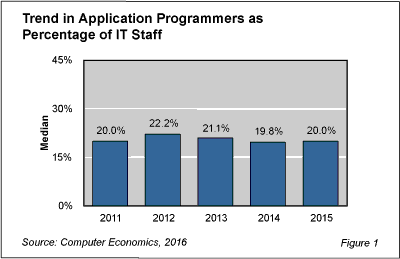While investment in enterprise applications continues to show relative strength, IT organizations have been holding their application programmer headcount steady.
Organizations are making more use of commercial software, reducing reliance on mainframes, subscribing to software as a service, and engaging in outsourcing. However, organizations are also actively developing mobile applications, expanding ERP platforms, and making greater use of business intelligence systems. As such, it is not clear how this category will fare relative to other IT functions over the long term.
As shown in Figure 1 from our study, Application Programmer Staffing Ratios, application programmers stood at 20.0% of the IT staff in 2015, where it has stood for for most of the period. The ratio temporarily jumped to 22.2% in 2012, at the start of a recovery in IT hiring, but then returned to its current level.

Application programmers make up the single largest portion of the IT staff in most organizations today, on average about one-fifth of the IT organization headcount. As organizations make more use of commercial software, reduce reliance on mainframes, subscribe to software as a service, or engage in outsourcing, they have less need of application programmers.
One IT veteran put it this way: “Many companies are using more SaaS apps. All they require is adapting to the API (application programming interface), and that doesn’t require as much application development effort as in the past. When companies were building custom applications for big back-end systems, it took months and a lot of expertise. Now, companies are shifting to cloud-based virtualized systems and app development is much easier.”
However, in the post-recession era organizations are continuing to invest in mobile and enterprise applications. In addition to developing applications, enterprises need application programmers to maintain systems, provide technical support, and modify existing systems. Application programmers remain a key element of nearly every IT organization.
With the changing environment, the need for application programmers is in flux, and IT organizations can benefit from a periodic assessment of their application development and maintenance staffing levels.
What is the typical staffing level today? The full study uses three metrics to make that assessment: application programmers as a percentage of the IT staff, users per application programmer, and applications per application programmer. We provide benchmarks for the composite sample, by organization size, and by sector. We also provide a benchmark for the larger Application Group, which includes personnel engaged in web development and support, quality assurance and testing, data management, and business systems analysis.
This Research Byte is a brief overview of our report on this subject, Application Programmer Staffing Ratios. The full report is available at no charge for Computer Economics clients, or it may be purchased by non-clients directly from our website (click for pricing).
Do you also need staffing ratios for other IT job functions? Consider this collection of all of our staffing ratio reports, which bundles them all into a single report at a significant discount: IT Staffing Ratios–Special Report Bundle.

